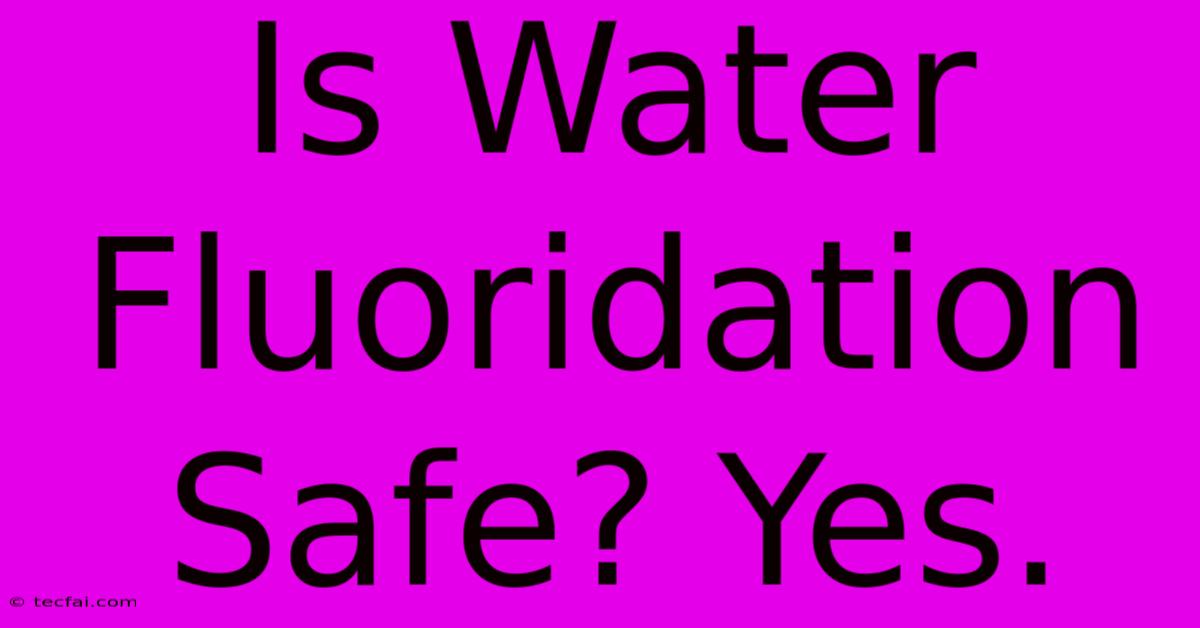Is Water Fluoridation Safe? Yes.

Discover more detailed and exciting information on our website. Click the link below to start your adventure: Visit Best Website tecfai.com. Don't miss out!
Table of Contents
Is Water Fluoridation Safe? Yes.
The question of water fluoridation safety sparks passionate debate. While concerns exist, the overwhelming scientific consensus supports its safety and effectiveness in preventing tooth decay. This article examines the evidence, addressing common anxieties and highlighting the benefits of this public health measure.
Understanding the Science Behind Fluoridation
Water fluoridation involves adding a small amount of fluoride – typically in the form of sodium fluoride or fluorosilicic acid – to public water supplies. This isn't about adding massive quantities; the concentration is carefully controlled to achieve optimal oral health benefits. The fluoride ions work by strengthening tooth enamel, making teeth more resistant to acid attacks from bacteria and sugars that cause cavities.
How Does Fluoride Work?
Fluoride works on multiple levels:
- Enamel Strengthening: It integrates into the developing tooth enamel during childhood, making it harder and more resistant to decay.
- Remineralization: Fluoride helps repair early stages of tooth decay by promoting the remineralization of enamel.
- Bacterial Inhibition: It can also inhibit the growth of bacteria responsible for tooth decay.
Addressing Common Concerns About Fluoridation Safety
Despite the substantial evidence supporting fluoridation, several concerns frequently arise. Let's address them directly:
1. Fluoride Toxicity: Is it Dangerous?
The amount of fluoride in fluoridated water is incredibly small. While excessive fluoride intake can lead to fluorosis (a discoloration of teeth), this is extremely rare at the levels used in water fluoridation. Severe fluorosis, affecting bone health, is only observed with significantly higher fluoride levels than those found in public water supplies. The risk is minimized further by the body's natural ability to excrete excess fluoride.
2. Is Fluoridation a Violation of Personal Rights?
Some argue that fluoridation violates personal autonomy, as individuals may not want fluoride added to their water. However, public health measures often involve collective action to improve overall well-being. Many other public health interventions, such as chlorination of water to prevent waterborne illnesses, are implemented without requiring individual consent. Alternatives like fluoride tablets or topical treatments are available for those with concerns about fluoridated water.
3. Are There Alternative Methods for Preventing Cavities?
Yes, there are other ways to prevent cavities, including good oral hygiene practices (brushing and flossing), regular dental checkups, and using fluoride toothpaste. However, water fluoridation acts as a broad public health measure, particularly benefitting children from low-income families who might not have access to regular dental care or fluoride-rich products.
The Significant Public Health Benefits of Water Fluoridation
Decades of research unequivocally demonstrates the positive impact of water fluoridation on dental health. Studies have consistently shown a significant reduction in tooth decay rates in communities with fluoridated water. This translates to fewer cavities, less need for extensive dental work, and ultimately, better overall oral health and improved quality of life, especially for children.
Reduced Health Disparities
Water fluoridation contributes to reducing health disparities related to dental health. It reaches a wide population, ensuring that everyone, regardless of socioeconomic status, benefits from its preventative effects.
Conclusion: The Safety and Efficacy of Water Fluoridation
The evidence overwhelmingly supports the safety and efficacy of water fluoridation. While concerns exist, they are largely unfounded when considering the carefully controlled levels of fluoride used and the overwhelming scientific consensus. Water fluoridation remains a cost-effective and highly effective public health intervention that significantly reduces tooth decay and improves oral health for entire communities. The benefits far outweigh the extremely low risks. The debate should not be about whether it's safe, but about how to ensure equitable access to this vital public health measure for everyone.

Thank you for visiting our website wich cover about Is Water Fluoridation Safe? Yes.. We hope the information provided has been useful to you. Feel free to contact us if you have any questions or need further assistance. See you next time and dont miss to bookmark.
Featured Posts
-
Two Held At Gatwick Suspect Package Found
Nov 23, 2024
-
Kendrick Lamars Surprise Album Gnx
Nov 23, 2024
-
Calgary Flames First Round 2025 Nhl Draft
Nov 23, 2024
-
Daniel Jones Released By Giants
Nov 23, 2024
-
Jury Rules On Mc Gregor Sexual Assault Case
Nov 23, 2024
